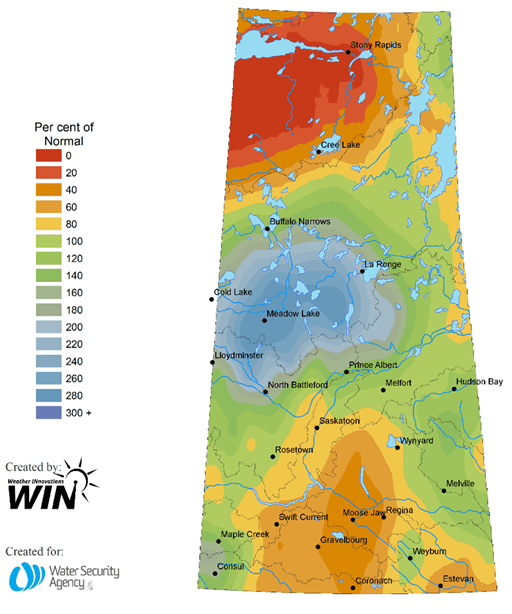Released on July 12, 2022
The Water Security Agency has prepared the Water Supply Conditions and Outlook report for July. While rainfall varied across the province in June, lake and reservoir levels across most of Saskatchewan are near normal and surface water supplies have improved over the past month.
Below is a snapshot by area:

Northern Saskatchewan
In northern Saskatchewan, precipitation varied from well below normal in the far northwest to well above normal in southern and eastern areas. Thunderstorm activity resulted in precipitation varying locally as well. The additional runoff in the Churchill River Basin has resulted in flows being above normal across the basin.
Southeast
In the southeast corner of the province, lower than normal rainfall helped dry out areas that had become saturated, allowing flows to recede. The central grain belt also saw lower than normal precipitation resulting in drier than normal soil conditions there. Heavy rainfall localized in the upper portion of the Wascana Creek Basin generated high runoff resulting in some flooding of agricultural land in the Kronau Marsh area.
Central
East-central and northeastern areas of the grain belt saw higher than normal precipitation leading to generally wet conditions.
Southwest
Southwest Saskatchewan saw above normal rainfall helping to continue to improve conditions from last year's extremely dry conditions; however, most of this region still has below normal moisture levels.
Lake Diefenbaker
A significant precipitation event in Alberta generated some welcomed inflows into Lake Diefenbaker on the South Saskatchewan River. Inflows are currently above normal for this time of year and helping to raise water levels in Lake Diefenbaker. The snowpack in the alpine region of the basin is mostly depleted. Some snow remains in the higher elevations of the alpine region but is not expected to cause significant runoff.
North Saskatchewan River
The heavy rainfall event in Alberta also hit the headwaters of the North Saskatchewan River Basin, generating above normal flows on the North Saskatchewan River and ultimately on the Saskatchewan River. Flows on the North Saskatchewan River are expected to remain above normal throughout July. Flows on the Saskatchewan River are expected to drop to slightly below normal levels over the next month.
Qu'Appelle
On the Qu'Appelle River System, nearly all the lakes are sitting near the top of their summer operating ranges, and with normal amounts of precipitation, all the lakes are expected to maintain a water level close to the targeted summer operating level. The exception is Round Lake, which is expected to remain low throughout the summer.
The full report can be found at wsask.ca. The agency continues to monitor water supply across the province and will produce supply reports monthly through to November 2022.
-30-
For more information, contact:
Sean Osmar
Water Security Agency
Phone: 306-630-4643
Email: Sean.Osmar@wsask.ca

